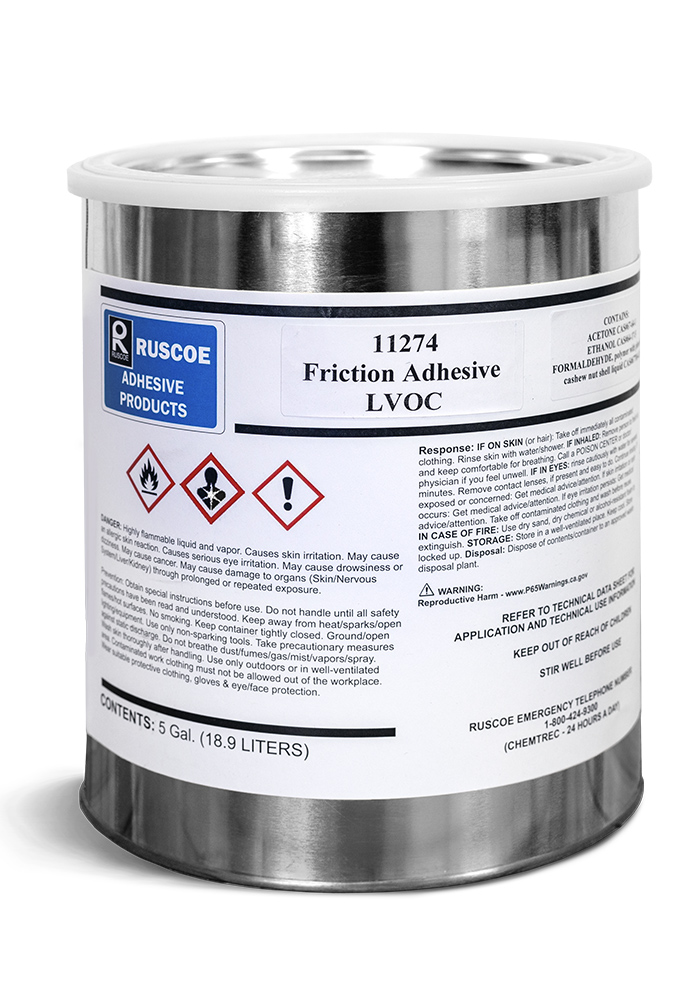Reliobond® 11274 LVOC Friction Adhesive
Reliobond® 11274 is a nitrile rubber and phenolic resin adhesive designed for bonding friction material to metal. This adhesive offers high bond strength across a wide range of temperatures. Cured Reliobond 11274 has excellent resistance to oil, grease, transmission fluid and brake cleaning fluid.
SUGGESTED USES
Used heavily in brake, paper, clutch and transmission part applications.

Reliobond® 11274 Friction Adhesive does not require mixing before application and can be reduced to a desired viscosity/solids using acetone or methyl acetate. This adhesive can be applied to the friction material to metal substrate. Experimentation is necessary to determine the optimum thickness and coating pattern for each part design.
For friction paper applications like clutch rings and transmission bands, the adhesive is usually roll coated or curtain coated. For clutch or transmission parts, a dry film thickness of 1-3 mils (0.001”-0.003”) is a recommended starting range. The optimum film thickness allows for full wetting of adhesive onto the metal surface during cure but does not squeeze out of the bond line or penetrate too deeply into the friction paper.
Bonding surfaces must be free of moisture, oils, dirt and other contaminates. Typical cleaning processes include aqueous alkaline cleaners, solvent vapor cleaners or burning or baking contaminates off the surface. After cleaning, a surface preparation process like phosphating, grit blasting or wheel abrading will enhance the adhesive bond. Reliobond 11274 Friction Adhesive will bond very well to a clean, bare metal surface, but preparing the surface with one of these methods will improve the consistency and overall strength of the bond.
DRYING
11274 Friction Adhesive must be fully dried before curing. Residual solvent in the adhesive can cause a weak, “spongy”, “blown” bond. It is difficult to recommend exact drying parameters. Environmental conditions, coating thickness and drying equipment type all significantly affect dry time.
Here are some general guidelines for drying:
- Do not exceed 230°F (110°C) at the adhesive surface as higher temperatures can prematurely cure the adhesive or cause blistering of the adhesive film.
- Air flow in the drying oven is crucial to achieving fast dry times. More air flow will reduce dry time.
- Contact Ruscoe Technical Service for a test procedure to determine if your part is fully dried.
CURING
The phenolic resins in Reliobond 11274 generate water vapor during cure. This water vapor must be forced out of the adhesive using pressure during the cure cycle. Most bonding problems with this type of adhesive are related to inadequate or uneven pressure. At least 100 psi must be continuously and uniformly applied during the curing process to ensure a good bond.
Reliobond 11274 adhesive will cure in the temperature range of 300-450°F (148-232°C). Keep in mind that this is the temperature that the adhesive must reach, not the oven setting. The adhesive will take longer to cure at lower temperatures but will allow more time for water vapor to escape and for adhesive to flow and wet the metal surface. Curing at too high of a temperature can cause the adhesive to gel quickly which will trap water vapor in the adhesive and cause a weak bond. Experimentation is required to determine the optimum cure cycle for each part design. A good starting point is to cure for 30 minutes at 400°F (204°C) at 200 psi.
Reliobond® 11274 Friction Adhesive is flammable and should be stored in tightly sealed containers away from direct sunlight, heat, sparks or other potential sources of ignition. Shelf life is 12 months when stored below 90°F in unopened containers. Parts that have been coated and dried can be bonded within 12 months if stored in a clean, dry area at temperature below 100°F (30°C).
Health and safety data sheets available upon request at The Ruscoe Company.
Typical Properties:
| Color | Black | |
| Solids, by Weight % | 33% – 36% | |
| Solvent Formulation | Acetone, Ethanol | |
| Viscosity, Brookfield, Spindle # | #5 | |
| Viscosity, Brookfield, Test RPM | 10 rpm | |
| Viscosity, Brookfield, Test Result, CPS | 5,000 – 15,000 | |
| Pounds Per Gallon @ 77°F (25°C) | 7.4 | |
| Calculated VOC | 188 g/L |
Performance Properties:
| Shear Strength (@75°F) | 3,500 psi | |
| Shear Strength (@400°F) | 500 psi | |
| Button & Bar Shear Strength Test (SAE J840 Rev C) | Cured 1 hour @ 400°F and 350 psi |
